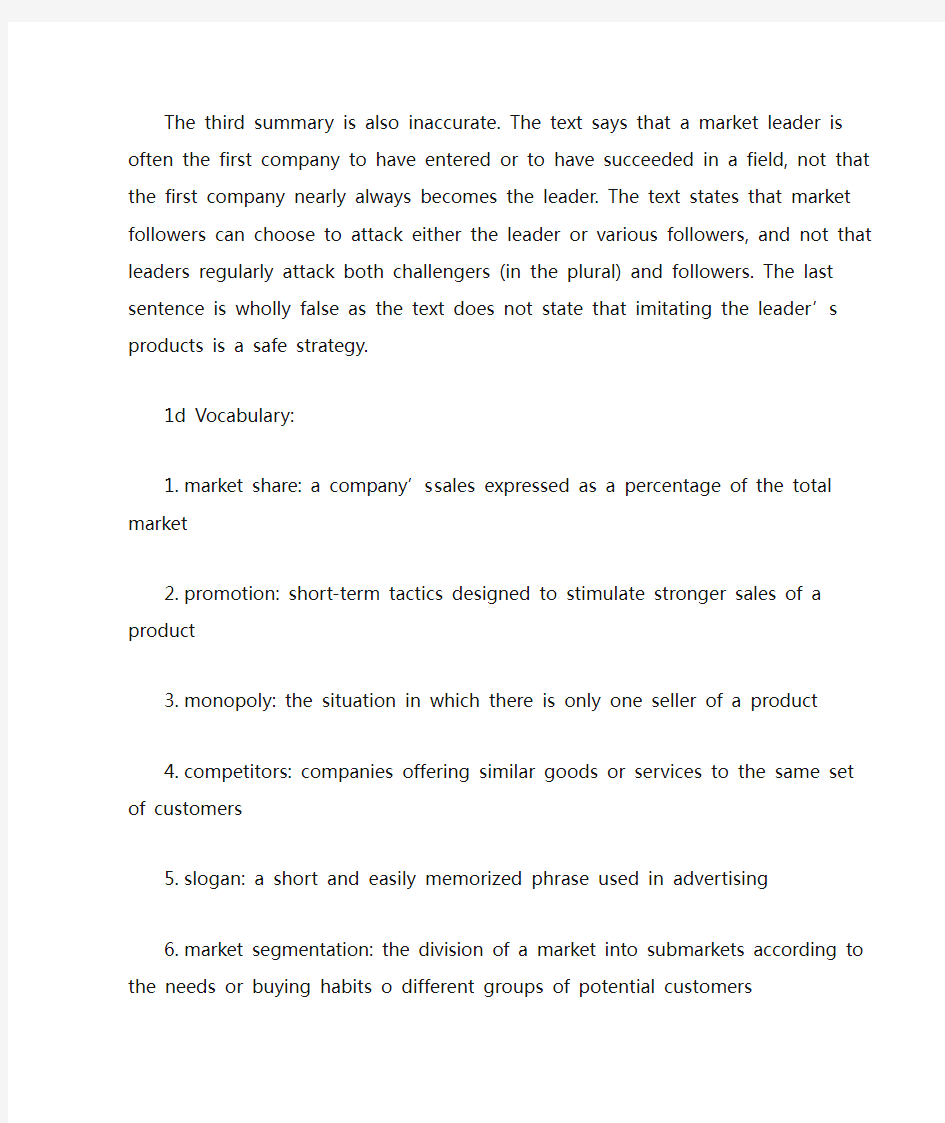Unit 18 Market structure and competition


Unit 18 Market structure and competition
1b Reading
1.Market leaders
2.Expanding markets
3.Market challengers
4.Market followers
5.Establishing a niche/ Dangers faced by market followers
1c Comprehension
The second summary is the only accurate one.
The first sentence of the first summary is clearly false. The last sentence of the first paragraph of the text, ‘The market leader is frequently able to lead other firms in the introduction of new products’, means that other companies are obliged to follow, not that the leader helps them. The last sentence is equally inaccurate: the fifth paragraph of the text says that a product that merely imitates and has no unique selling proposition is always a risk, not only during recessions. The third summary is also inaccurate. The text says that a market leader is often the first company to have entered or to have succeeded in a field, not that the first company nearly always becomes the leader. The text states that market followers can choose to attack either the leader or various followers, and not that leaders regularly attack both challengers (in the plural) and followers. The last sentence is wholly false as the text does not state that imitating the leader’s products is a safe strategy.
1d V ocabulary:
1.market share: a compa ny’s sales expressed as a percentage of the total market
2.promotion: short-term tactics designed to stimulate stronger sales of a product
3.monopoly: the situation in which there is only one seller of a product
https://www.wendangku.net/doc/4018948293.html,petitors: companies offering similar goods or services to the same set of
customers
5.slogan: a short and easily memorized phrase used in advertising
6.market segmentation: the division of a market into submarkets according to the
needs or buying habits o different groups of potential customers
7.niche: a small and specific market segment
8.differential advantage: a factor which makes you superior to competitors in a
certain respect
9.turnover: a business’s total sales revenue
10.recession: a period during which an economy is working below its potential 2a V ocabulary
1.perfect competition
2.monopoly
3.monopsony
4.natural monopoly
5.monopolistic competition
6.oligopoly
7.economies of scale
8.barriers to entry
9.dominant-firm oligopoly
10.cartel
2b Comprehension
1.a monopsoney (the government should be the only buyer)
2.an oligopoly
3.perfect competition
4.monopolistic competition (because of consumer preference for several
marginally different brands, which creates fragmented markets too small to allow many competitors)
5.a dominant-firm oligopoly (IBM—although, of course, mainframes have now
widely been replaced by smaller computers)
6.a monopoly (regarding ownership of the railway tracks, it not always train
services)
2c Reading
First paragraph: L, J, F, M, I
Second Paragraph: D, C, B
Third paragraph: K, H, G, E, A
New words in this unit 18
Barriers to entry, cartel, dominant-firm oligopoly, entrepreneur, marginal cost, market challenger, market concentration, market follower, market leader, market structure, monopolistic competition, monopoly, monopsony, natural monopoly, oligopoly, patent, product differentiation, unique selling proposition
